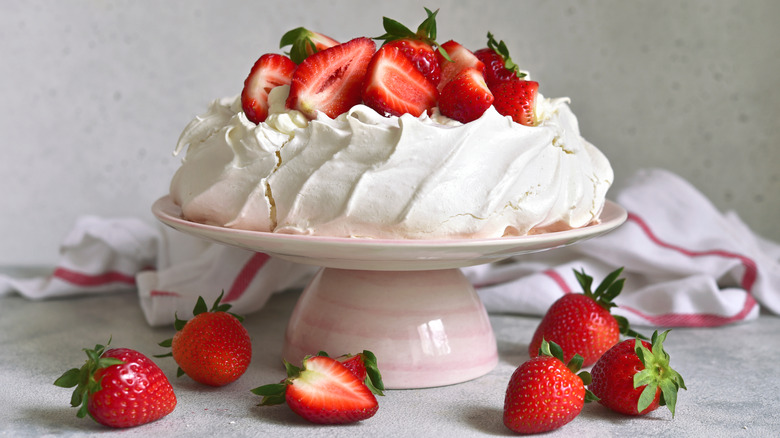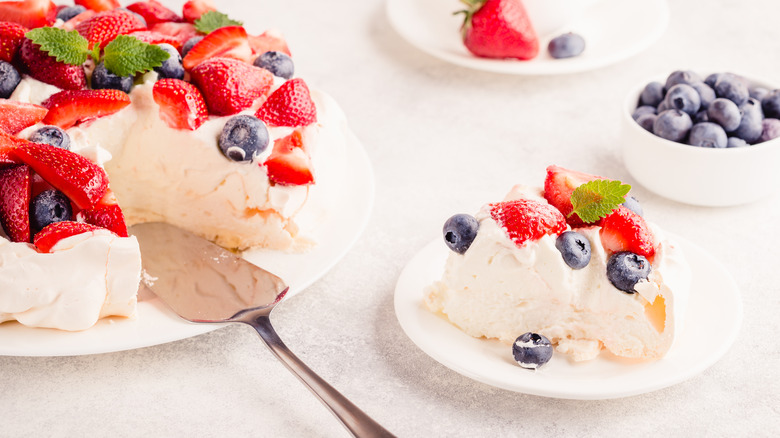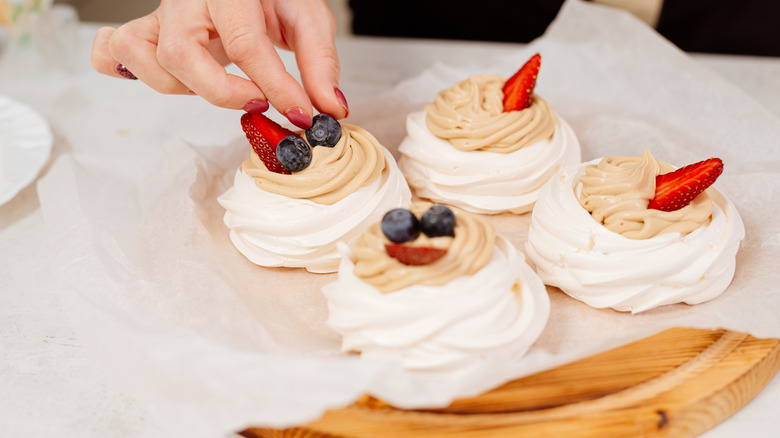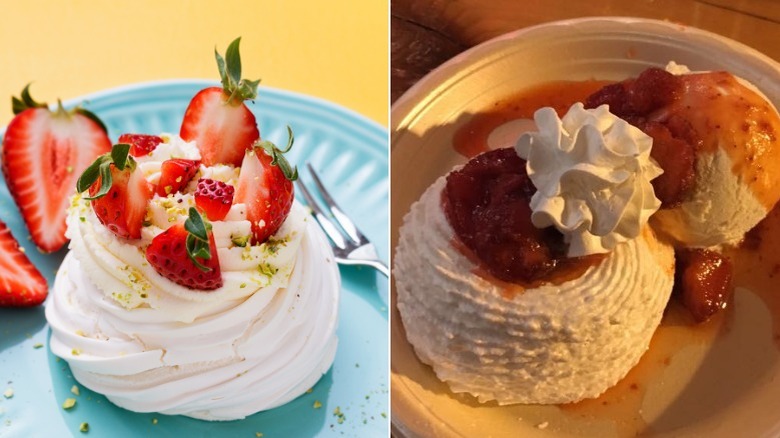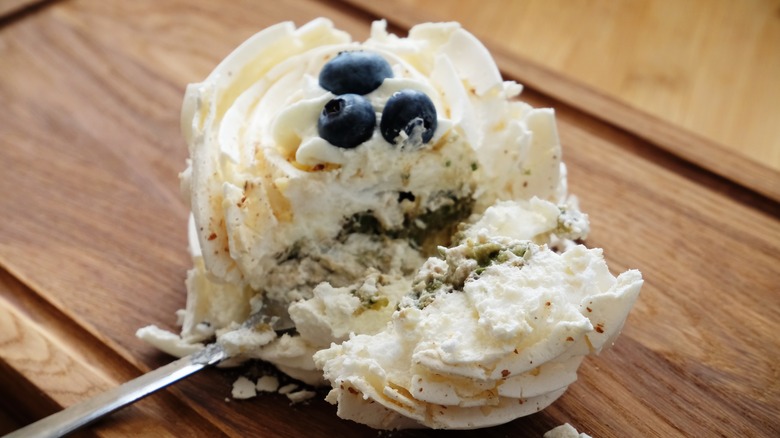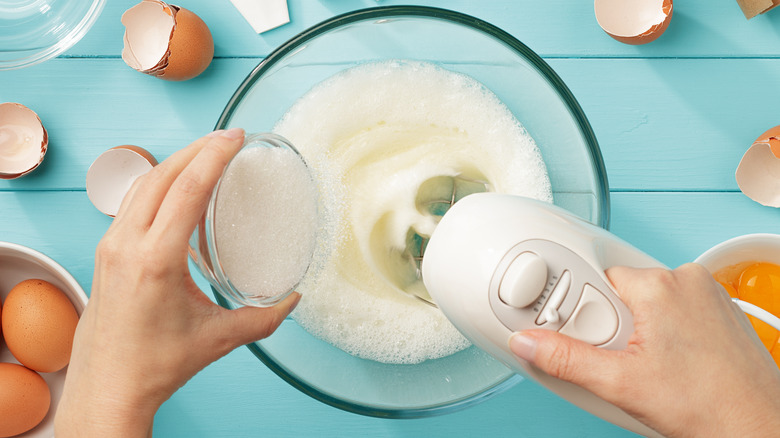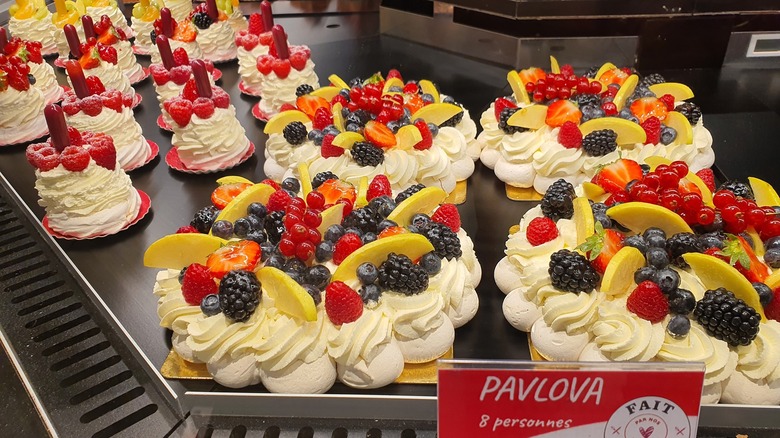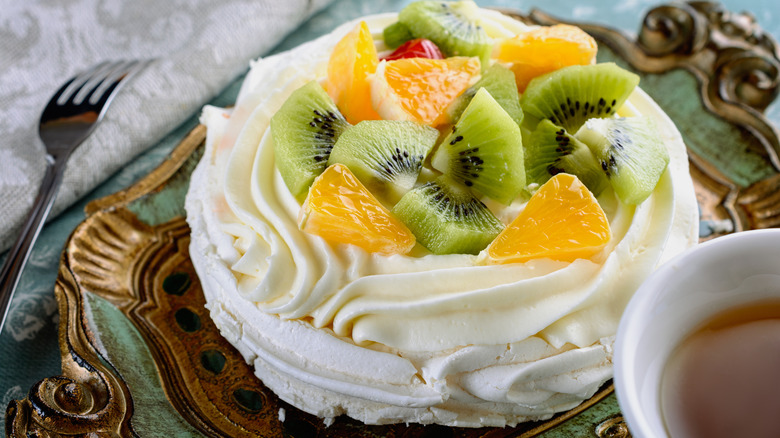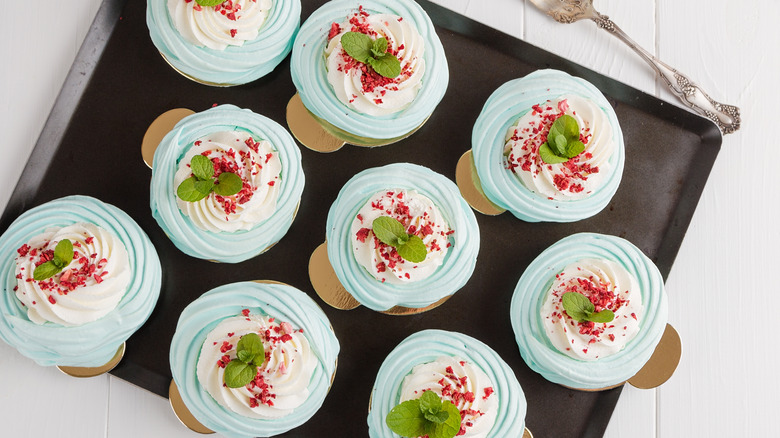What Is Pavlova And What Does It Taste Like?
We may receive a commission on purchases made from links.
A surprising number of foods are of the name of an actual person. Sometimes they get their name from the person who invented the dish, as in the case of the Earl of Sandwich who was, allegedly, the first to eat meat in between two slices of bread (per STYLIST). More often, a meal is named for some prominent person that the chef wishes to honor, such as the pizza Margherita, which was created to impress the Italian queen, or Oysters Rockefeller, a seafood dish named after the richest man of 1889 — John D. Rockefeller.
This was the case for Russian ballerina, Anna Pavlova, who held a successful round of tours in the Antipodes in the 1920s and audiences adored her. The world-famous ballerina's bourrées and jetés were described as lighter than air, just like the meringue-based cake that bears her name. The BBC notes that the dessert that was named for her is claimed as an invention of chefs in New Zealand and Australia both, but the exact origin of where the pavlova came from remains a mystery.
What is a pavlova?
Although it sounds complex, pavlova is a decadent, yet airy, meringue cake made of whipped egg whites, sugar, and is typically topped with fresh fruits.
As the BBC reports, the "pav" is one of the best-known desserts Down Under, equally at a backyard barbecue or taking pride placed in the center of a holiday table. Of course, below the equator, Christmas is a summer holiday so the festive meal very well may include barbecue. Those less familiar with pavlova may be thrown off by its elegant appearance thinking that it certainly doesn't seem like something that would belong at a barbecue.
As to why the pavlova is seen as a summertime dessert, that most likely has to do with the fact that it's super-light, but Broma Bakery is lobbying for more people to adopt the pavlova as a year-round dessert, as something so amazing doesn't deserve to be relegated to one all-too-short season.
How is pavlova made?
According to Broma Bakery, the making of pavlova starts with egg whites. The egg whites are beaten until they form soft peaks, then sweetened with sugar and stiffened with a little bit of corn starch. While the pavlova is seen as a type of cake, it's not baked in a cake pan. Rather, the meringue batter is piled up into a tall, cake-shaped cylinder. It can also be sculpted into swirly shapes or other desired designs since it will keep its shape when baked.
As far as baking goes, low and slow is the way to go with a pavlova recipe. Bake it at 200 degrees Fahrenheit and it should take about an hour and a half to be done. It then needs to sit in the oven for an hour after the heat has been turned off, and carefully removed from the baking sheet before being finished off with whipped cream and fruit, or other desired toppings.
Pavlova vs. schaum torte
According to Miss Vickie PRESSURE COOKER Times, if you're of German descent, or you come from Wisconsin, you may be reading the description of the pavlova and thinking it sounds rather familiar. Isn't that fruit-topped meringue dessert pretty much the same as a schaum torte? Yes, pretty much. The two desserts are really quite similar apart from their origins, as the latter came from Germany and is now considered to be a regional specialty in the heavily German-influenced city of Milwaukee. Pavlova, as already mentioned, is believed to be a product of Australia rather than Europe.
If there is any real difference between the two desserts, it's that pavlova tends to include corn starch while the schaum torte does not, so it lacks the soft center. The source also notes that schaum torte is typically topped with strawberries, but can also be enhanced with sweet syrup or even a scoop of ice cream. In keeping with the pavlova's area of origin, the fruits used to top it may be locally grown to that area, such as kiwi and passion fruit.
What does pavlova taste like?
One possible origin story for the pavlova credits an Australian chef named Herbert Sachse who had long been experimenting with a meringue cake recipe that wouldn't be too hard or too crusty. As he told Woman's Day in 1973 (via the BBC), "I set out to create something that would have a crunchy top and would cut like a marshmallow." Whether or not Mr. Sachse is the true creator of the pavlova is unclear, but he did describe the texture pretty well. In 1935, while Sachse was working at the Esplanade Hotel in Perth, he finally perfected that recipe.
Broma Bakery says that the flavor of the meringue is also similar to that of a marshmallow and adds that as you work your way from the crispy exterior to the airy interior, you'll hit upon a little bit of chewiness as well. The meringue itself tastes of sugar and perhaps vanilla, but the pavlova also gains some richness from the whipped cream and a little bit of tang from the fresh fruit that crowns it.
You can, if you like, depart from the classic whipped cream/fresh fruit combo when it comes to finishing off your pavlova. Lemon curd or jam are popular toppings, or you could use chocolate syrup, coconut, or nuts for a different — but equally delicious — flavor profile.
How to make pavlova
If you've ever seen a pavlova in a bakery, you might view it as the kind of dessert that would be too difficult to recreate in your own kitchen. Thousands of Aussies however, would beg to differ. No worries, they'd tell you, your home-baked pavlova would be bonzer!
Broma Bakery offers a couple of tips for making a pavlova at home. They say to use granulated sugar, as it not only sweetens the whipped egg whites, but also helps to aerate them and add some crunch to the outer layer. The bakery emphasizes the importance of beating the sugar into the eggs long enough to dissolve the granules, noting that if you rush through this step, you run the risk of having a pavlova with a gritty texture. Pro tip: Run the sugar through the food processor or blender before using it as the finer the texture, the more quickly it will dissolve.
You'll also need a tiny bit of acid such as lemon juice, white vinegar, or cider vinegar, to prevent the egg whites from collapsing. Using corn starch will help to absorb any excess moisture provided by the vinegar and create that gooey center.
Where to buy pavlova
In the U.S., a pavlova isn't the type of dessert you're likely to find in a standard supermarket bakery. It may be available from local independent bakeries, particularly the ones that specialize in fancier types of French pastries or cakes. As the items in stock at such bakeries tend to fluctuate due to supply, demand, or what the baker feels like making on any given day, it's best to call ahead and inquire about the availability should you have your heart set on a pavlova.
Unfortunately, the pavlova is such a delicate type of cake that it doesn't do well when shipped, so while you can order a pavlova online, it's likely to be for pickup only. One thing you can do, if you really don't want to make a pavlova from scratch, is try a meringue mix such as White Wings' Pavlova Magic (available from Amazon). You could also purchase meringue nests and try the Easy Eton Meringue Mess recipe.
Nutritional information about pavlova
There is good news for those with certain food restrictions, as the pavlova dessert is gluten-free. You can also swap the egg whites with aquafaba, making a vegan version of pavlova. In this instance, you'd also need to replace the whipped cream with whipped coconut milk or a similar plant-based product.
The standard, egg-based, cream-topped pavlova is a fairly healthy dessert. CalorieKing breaks down the nutritional profile of the pavlova available from Australia's Coles supermarket chain. Each Coles pavlova weighs 500 grams (a little over 1 pound) and provides 12 servings. A single serving, one slice weighing about an ounce and a half, has just 132 calories. This pavlova has only a trace of fat, at just .2 grams per serving. It does have 31 grams of carbs and just over 18 grams of sugar, so it's not exactly what you'd call "keto-friendly," but then, this could be said of many foods.
If you're making a homemade pavlova and want an even healthier version, that's easy to do. Skip any sugar-laden toppings, like jam or chocolate, and double up on healthy fresh fruits.
Pavlova gets the gourmet treatment
Pavlova is practically the national dessert of both Australia and New Zealand, but as both of these countries are part of the British Commonwealth of Nations, it should come as no surprise to find that it's extremely popular in the U.K. as well. Pavlova has made frequent appearances on "The Great British Baking Show," including when German baker, Jürgen Krauss, created an incredible Passover version topped with charoset and matzah (via the Jewish Telegraphic Agency).
GOURMET TRAVELLER lists a number of other pavlova recipes where this fairly simple dessert gets the gourmet treatment. These include a Chinese pavlova flavored with Sichuan peppercorns and topped with passionfruit ice cream; a wreath-shaped pavlova adorned with rose petals, watermelon balls, Turkish delight, and honey-sweetened yogurt cream; and a brown sugar pavlova decorated with sugared hibiscus flowers, candied hazelnuts, fresh mango, and coconut-flavored crème fraîche.
